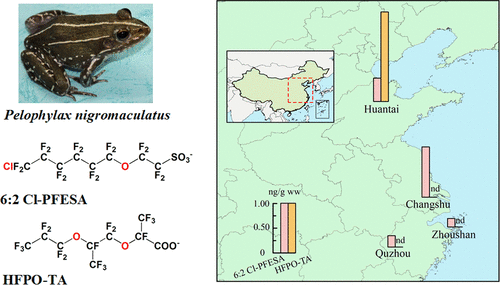当前位置:
X-MOL 学术
›
Environ. Sci. Technol.
›
论文详情
Our official English website, www.x-mol.net, welcomes your
feedback! (Note: you will need to create a separate account there.)
Occurrence and Tissue Distribution of Novel Perfluoroether Carboxylic and Sulfonic Acids and Legacy Per/Polyfluoroalkyl Substances in Black-Spotted Frog (Pelophylax nigromaculatus)
Environmental Science & Technology ( IF 10.8 ) Pub Date : 2018-01-23 00:00:00 , DOI: 10.1021/acs.est.7b03662 Qianqian Cui 1, 2 , Yitao Pan 1 , Hongxia Zhang 1 , Nan Sheng 1 , Jianshe Wang 1 , Yong Guo 3 , Jiayin Dai 1
Environmental Science & Technology ( IF 10.8 ) Pub Date : 2018-01-23 00:00:00 , DOI: 10.1021/acs.est.7b03662 Qianqian Cui 1, 2 , Yitao Pan 1 , Hongxia Zhang 1 , Nan Sheng 1 , Jianshe Wang 1 , Yong Guo 3 , Jiayin Dai 1
Affiliation

|
Research on perfluoroalkyl substances (PFASs) continues to grow. However, very little is known about these substances in amphibians. Here we report for the first time on the occurrence, tissue distribution, and bioaccumulation of two novel PFASs, chlorinated polyfluorinated ether sulfonic acid (6:2 Cl-PFESA) and hexafluoropropylene oxide trimer acid (HFPO-TA), in the black-spotted frog (Pelophylax nigromaculatus) from China. Frogs from cities with large-scale fluorochemical industries had significantly greater liver ∑PFAS levels (mean 54.28 ng/g in Changshu; 31.22 ng/g in Huantai) than those from cities without similar industry (9.91 ng/g in Zhoushan; 7.68 ng/g in Quzhou). Females had significantly lower liver PFAS levels than males, and older frogs tended to have lower PFAS levels than younger frogs. Skin, liver, and muscle contributed nearly 80% to the whole body burden of 6:2 Cl-PFESA in males, whereas the female ovary alone accounted for 58.4%. These results suggest substantial maternal transfer of 6:2 Cl-PFESA to eggs, raising concern regarding its developmental toxicity on frogs and other species. The bioaccumulation factor results (6:2 Cl-PFESA > PFOS; HFPO-TA > PFOA) suggest a stronger accumulative potential in the black-spotted frog for these alternative substances compared to their predecessors. Future studies on their toxicity and ecology risk are warranted.
更新日期:2018-01-23


















































 京公网安备 11010802027423号
京公网安备 11010802027423号